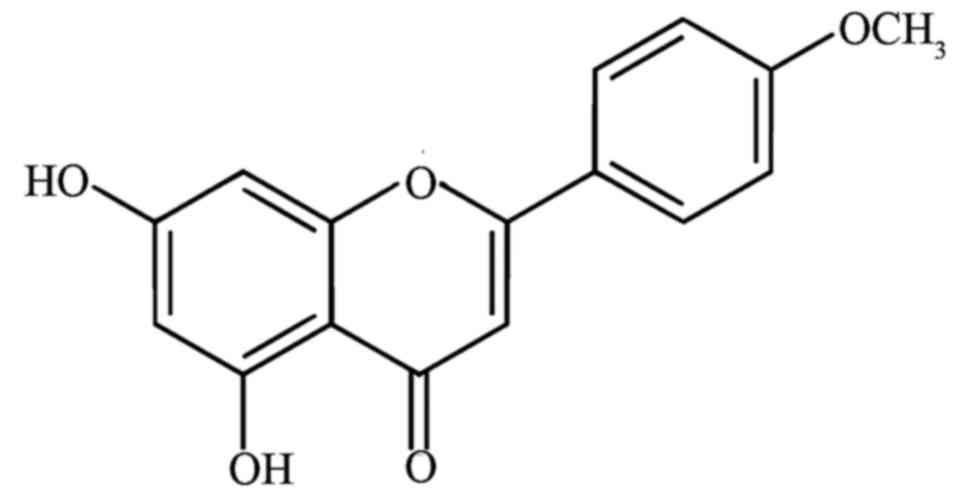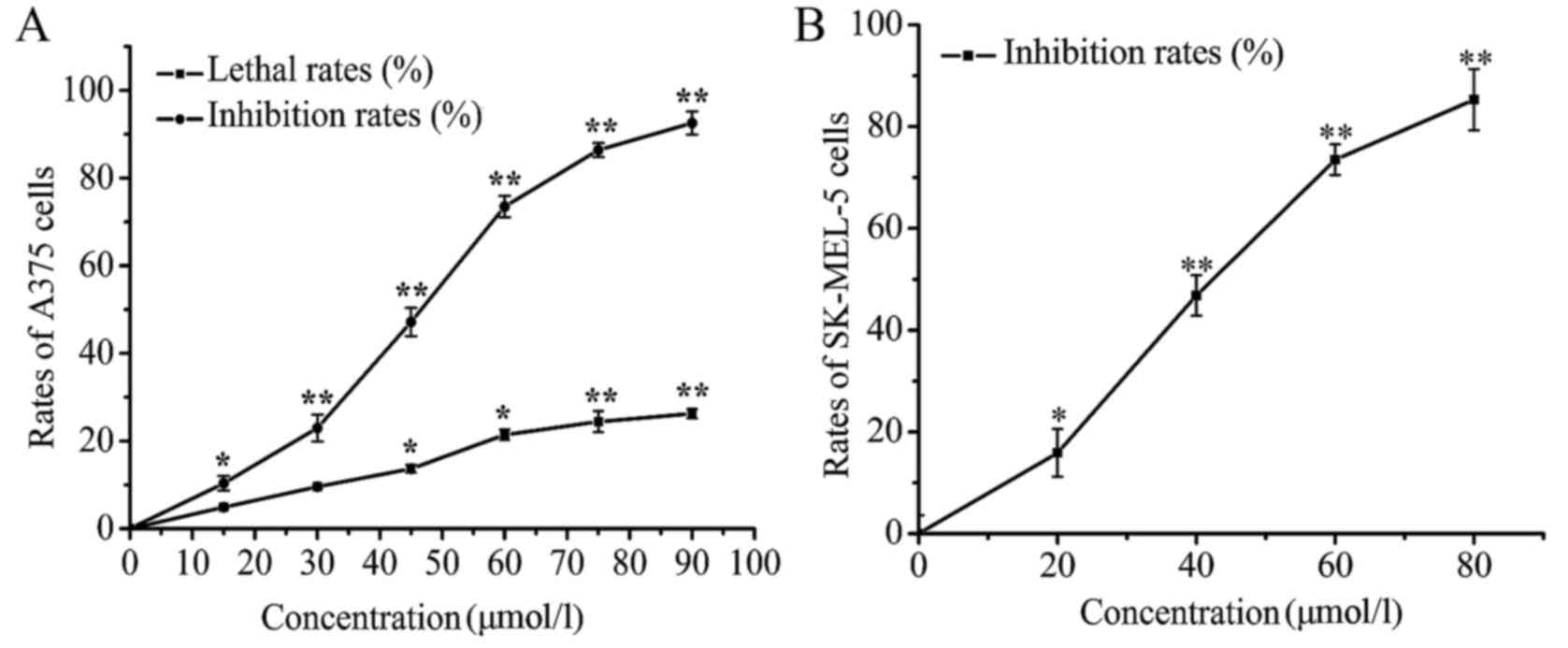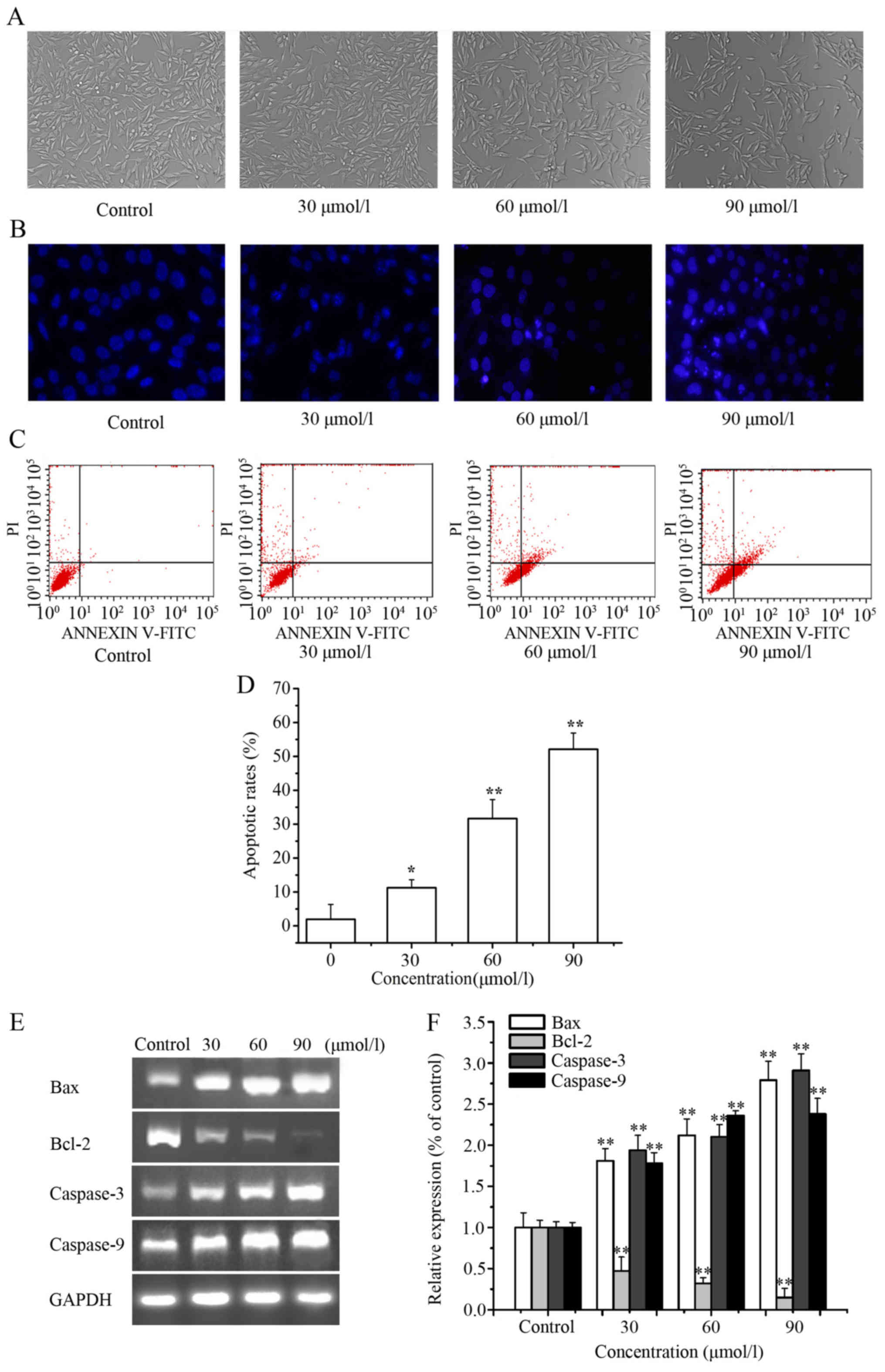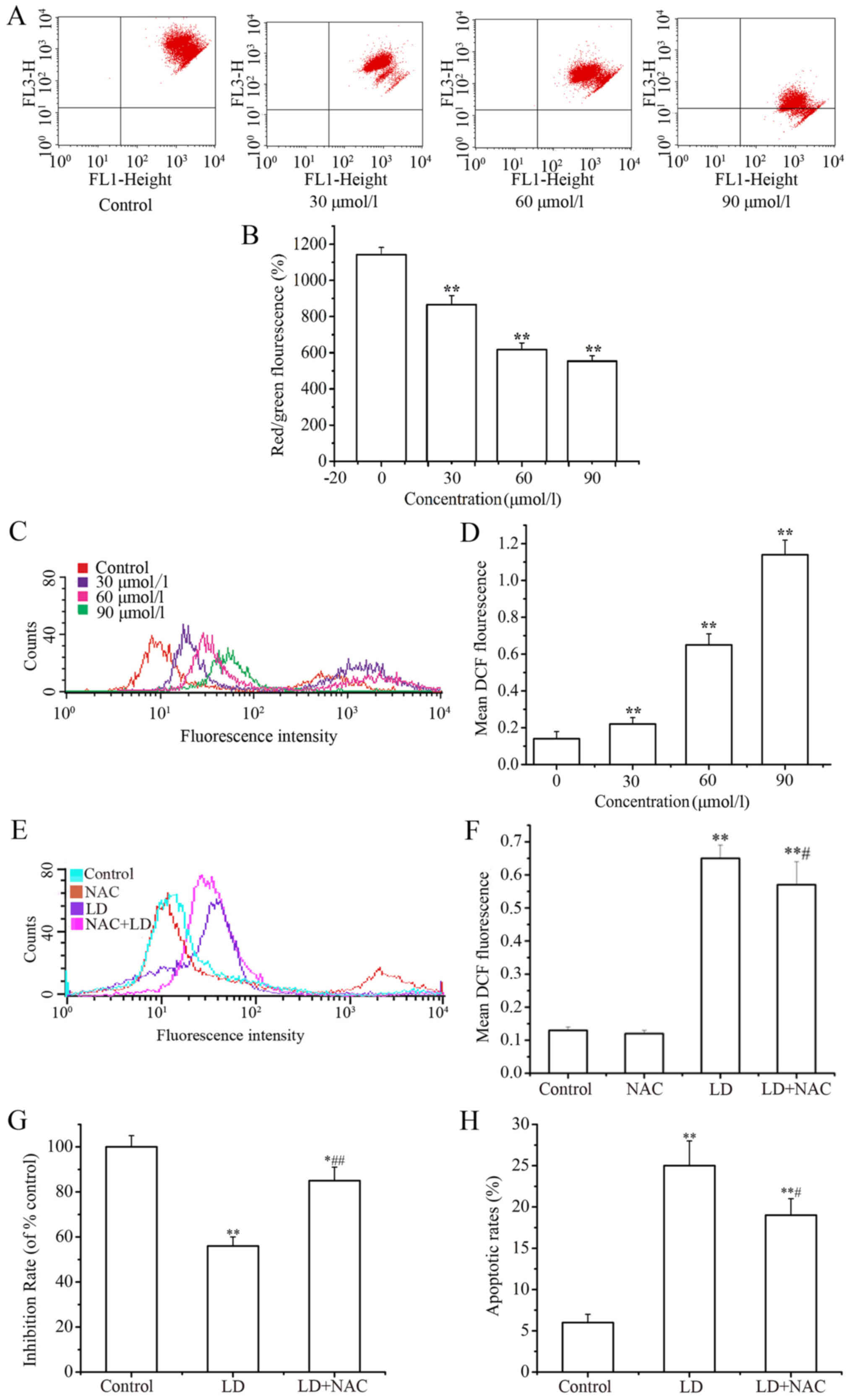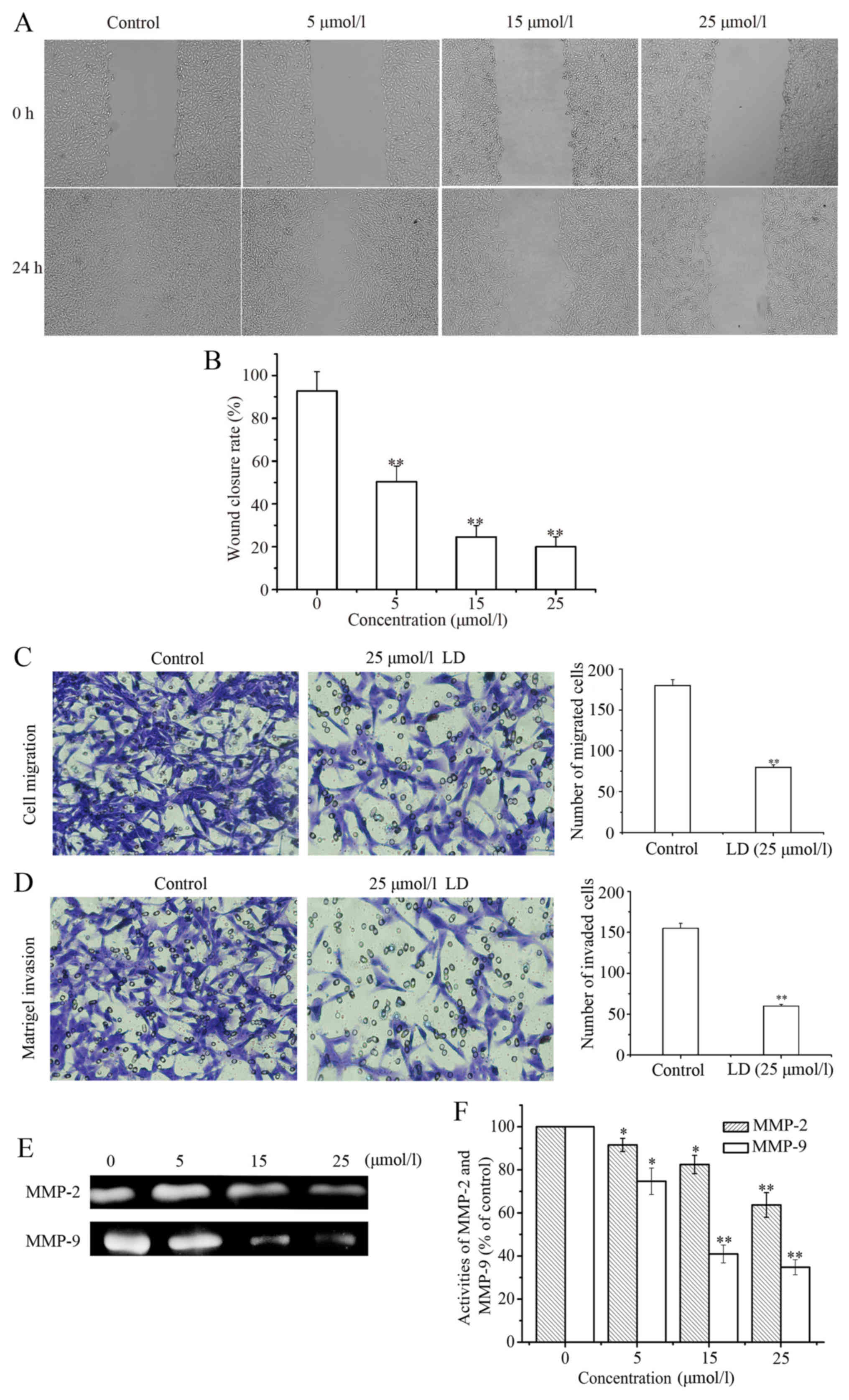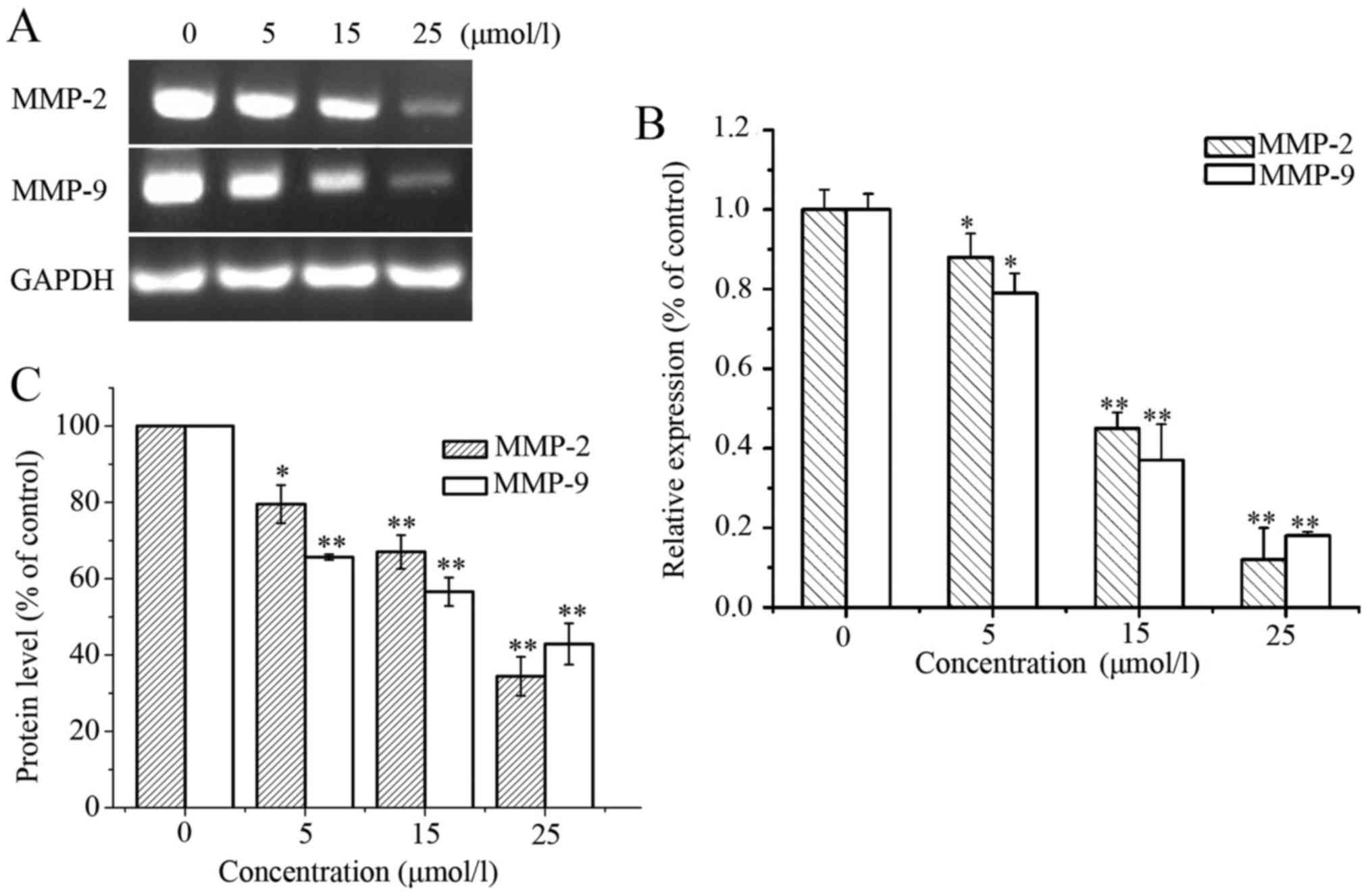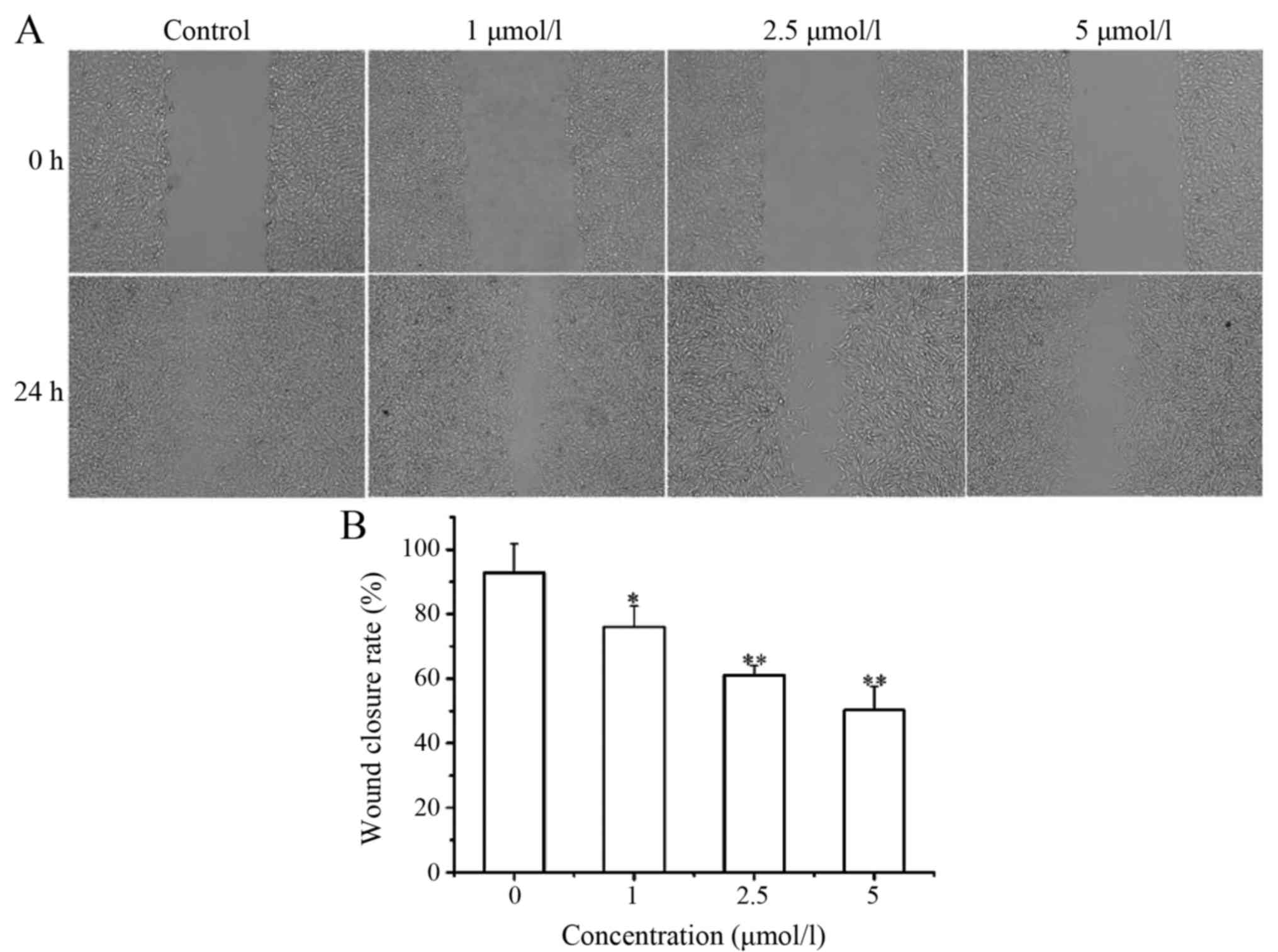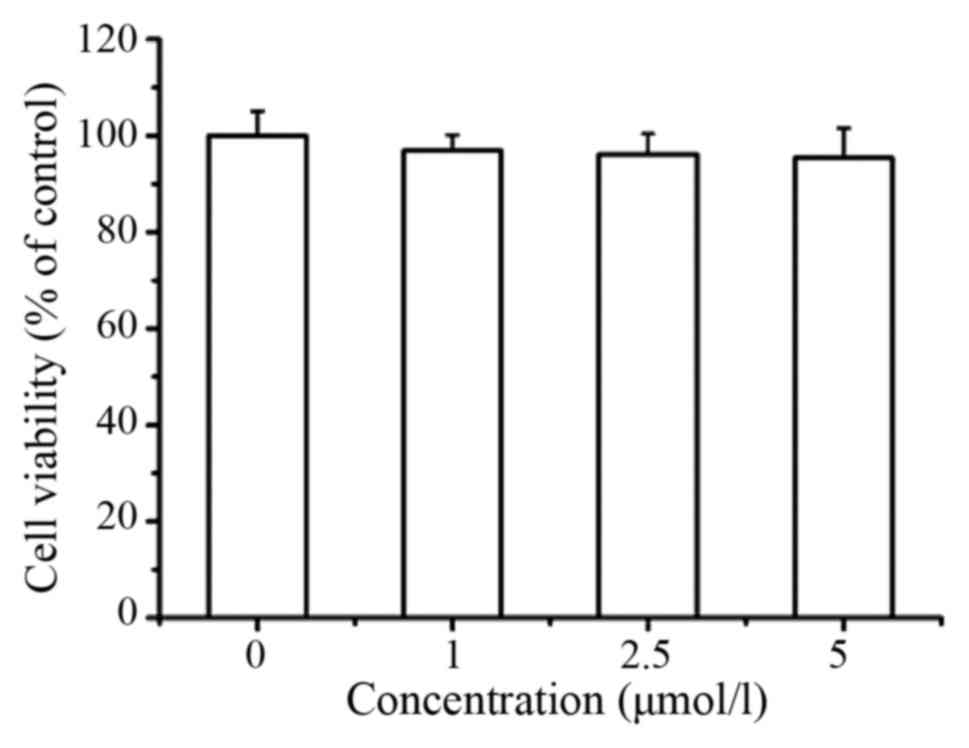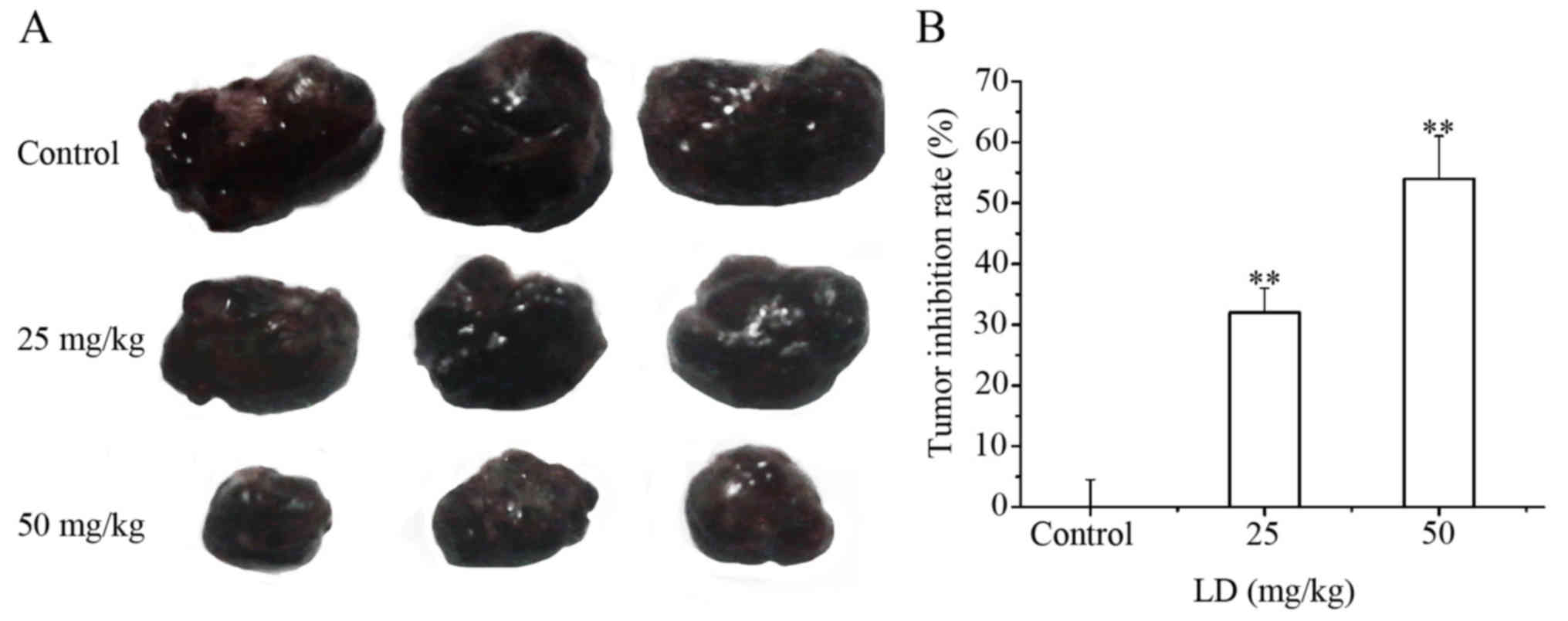Licochalcone D induces apoptosis and inhibits migration and invasion in human melanoma A375 cells
- Authors:
- Published online on: March 20, 2018 https://doi.org/10.3892/or.2018.6329
- Pages: 2160-2170
-
Copyright: © Si et al. This is an open access article distributed under the terms of Creative Commons Attribution License.
Abstract
Introduction
Malignant melanoma, accounting for the greater percentage of skin cancer cases is a highly lethal cutaneous tumor which has shown an increasing incidence in the last few decades (1). The conventional therapy for malignant melanoma includes surgery, chemotherapy, immunotherapy and radiation therapy (2). However, these therapeutic strategies are typically self-limited and far from satisfactory. The urgent task on hand is to seek an effective drug to improve the comprehensive treatment, reduce the side effects and reduce the mortality of melanoma.
It has been demonstrated that flavonoids have cytotoxic activities toward multiple types of human cancer cells, yet have little or no effect on normal cells. Numerous flavonoids in traditional Chinese herbs may be promising candidates for the development of novel anticancer drugs (3). Previously, we found that Licochalcone C induced apoptosis via B-cell lymphoma 2 family proteins in T24 cells (4). Licochalcone A induced T24 bladder cancer cell apoptosis by increasing intracellular calcium levels (5). Isoliquiritigenin inhibited proliferation and induced apoptosis via alleviating hypoxia and reducing glycolysis in mouse melanoma B16F10 cells (6). Recently, we demonstrated that Licochalcone B arrested cell cycle progression and induced apoptosis in human breast cancer MCF-7 cells (7). Taken together, these studies indicate the application potential of flavonoids for cancer therapy. Licochalcone D (LD, Fig. 1) is a flavonoid compound mainly existing in the root of Glycyrrhiza inflata, commonly named Chinese licorice which possesses antioxidant and anti-inflammatory properties (8–10). However, the effect of LD on the metastasis and apoptosis of A375 cells has never been reported. The present study was designed to evaluate the anticancer, metastatic and apoptotic effects of LD on A375 cells in vitro.
Materials and methods
Cell culture and treatment
A375 cells were purchased from the Cell Bank of the Committee on Type Culture Collection of the Chinese Academy of Sciences (Shanghai, China). B16F0 cells were obtained from the China Center for Type Culture Collection (Wuhan, China). SK-MEL-5 cells were purchased from the American Type Culture Collection (ATCC; Manassas, VA, USA). A375 cells were cultured in Gibco™ DMEM, while SK-MEL-5 and B16F0 cells were cultured in Gibco™ RPMI-1640 (Thermo Fisher Scientific, Inc., Waltham, MA, USA) containing HyClone™ 10% fetal bovine serum (FBS; GE Healthcare Life Sciences), 2 mM L-glutamine, 100 U/ml penicillin and 100 µg/ml streptomycin. All cell lines were cultured at 37°C in 5% CO2. Cells were allowed to attach for 24 h before treatment. LD was dissolved in dimethyl sulfoxide (DMSO) (Sigma-Aldrich; Merck KGaA, Darmstadt, Germany) and diluted with fresh medium to achieve the desired concentration. The final concentration of DMSO did not exceed 0.2% in the fresh medium, and DMSO at this concentration has no significant effect on cell viability.
Cell viability assay
A375 cells were trypsinized and seeded into 96-well plates at 105 cells/well. Thereafter, cells were exposed to LD (0, 1, 2.5, 5, 15, 30, 45, 60, 75 and 90 µmol/l) for 24 h. SK-MEL-5 cells were trypsinized and seeded into 96-well plates at 104 cells/well, and exposed to LD (0, 20, 40, 60 and 80 µmol/l) for 24 h, followed by extra incubation in fresh medium for another 24 h. The effect of LD-induced cytotoxicity was evaluated using sulforhodamine B (SRB) (Tokyo Chemical Industry Co., Ltd., Tokoy, Japan) assay as previously described (6). The optical density was detected at a wavelength of 490 nm.
Observation of morphological changes
A375 cells were trypsinized and seeded into 6-well plates at 2×105 cells/well. After being treated with LD (0, 30, 60 and 90 µmol/l) for 24 h, the cells were fixed with Carnoy's fixative consisting of methanol (Kaixin, Tianjin, China) and glacial acetic acid (3:1, v/v). Hoechst 33258 (5 µg/ml) (Solarbio, Beijing, China) was applied for visualization of the nucleus. The changes in nuclear morphology of apoptotic cells were observed by labeling the cells with the nuclear stain Hoechst 33258 and examining them under fluorescence microscopy at ×200 magnification (MIC00266; Carl Zeiss, Oberkochen, Germany). Cells that exhibited reduced nuclear size, chromatin condensation, intense fluorescence, and nuclear fragmentation were considered as apoptotic.
Trypan blue exclusion test
The lethality of LD on A375 cells was determined by the trypan blue exclusion test as previously described (11). After 24 h of incubation with LD (0, 30, 60 and 90 µmol/l), A375 cells were removed from the culture medium and cells that excluded trypan blue (Sigma-Aldrich; Merck KGaA) were counted in a Neubauer chamber.
Annexin V/PI staining assay
Annexin V-fluorescein isothiocyanate (FITC)/propidium iodide kit (BD Pharmingen, San Diego, CA, USA) was used to assess cell apoptosis according to the supplier's instructions (12). After treatment with LD (0, 30, 60 and 90 µmol/l) for 24 h, cells were collected, counted, centrifuged and resuspended in 500 µl of 1X binding buffer. Then Annexin V-FITC (5 µl) and PI (5 µl) were added to each sample. The samples were incubated in the dark at room temperature for 15 min and examined immediately on a flow cytometer (BD Biosciences, Franklin Lakes, NJ, USA). The assays were repeated at least three times.
RNA isolation, RT-PCR and qPCR
Semi-quantitative reverse transcription-PCR (RT-PCR) (13) and quantitative real-time PCR (qPCR) (14) were performed to examine the mRNA expression of Bax, Bcl-2, caspase-3, caspase-9, MMP-2 and MMP-9. The primer sequences (synthesized by Sangon Biotech Co., Ltd., Shanghai, China) are shown in Table I. Total cellular RNA was extracted using TRIzol reagent (Sangon Biotechnology Co., Ltd.), and then cDNA was synthesized with the use of 3 µl total RNA primed with oligo(dT) (deoxy-thymidine) (Fermentas, Vilnius, Lithuania) in 25 µl reaction solution. The resulting total cDNA was used in the polymerase chain reaction. The reaction conditions were established by 12.5 µl 2X PCR Master (Tiangen Biotech, Beijing, China), 3 µl cDNA template, and 0.5 µl of each primer. RT-PCR products were resolved on a 1.5% agarose gel, stained with ethidium bromide, and the intensity was quantified by Gel-Pro analysis software (ImageJ software, version 1.49n; National Institutes of Health, Bethesda, MD, USA). qPCR amplification was conducted using SYBR-Green q-RT-PCR kit reagents (Fermentas) according to the manufacturer's instructions. The cycling conditions were as follows: 95°C for 5 min, followed by 40 cycles of 95°C for 5 min, Tm (C) for 30 sec, and 72°C for 30 sec. For quantification, the relative gene expression was calculated using Ct methods.
Detection of ΔΨm by JC-1
A375 cells were incubated with LD (0, 30, 60 and 90 µmol/l) for 24 h, then washed with cold PBS, exposed to 500 µl JC-1 dye solution (KeyGen Biotech. Inc., Nanjing, China) and incubated at 37°C for 20 min in the dark. After washed three times with incubation buffer, the cells were diluted in 500 µl incubation buffer and the fluorescence intensity of the cells was analyzed using a FACScan flow cytometer (BD Biosciences). The wavelength at excitation/emission 485/580 nm (red), and then at excitation/emission 485/530 nm (green) was read by a fluorescent plate reader (Varioskan Flash 3001; Thermo Fisher Scientific, Inc., Waltham, MA, USA).
Detection of intracellular ROS levels
ROS in A375 cells were detected using a fluorescent probe-2,7-dichlorofluorescein diacetate (DCFH-DA) (Sigma-Aldrich; Merck KGaA) as previously described (15). When DCFH-DA penetrates cells, it is hydrolyzed to DCFH by an esterase which is oxidized to fluorescent DCF by intracellular ROS. Thus, 2×105 cells/bottle were incubated with the indicated concentration of LD (0, 30, 60 and 90 µmol/l) with or without ROS scavengers (N-acetyl-cysteine; NAC) (Sigma-Aldrich; Merck KGaA) for 24 h, then cells were incubated with DCFH-DA (30 µmol/l) at 37°C for 30 min and washed with PBS, and the fluorescence intensity of the cells was analyzed using a FACScan flow cytometry (BD Biosciences). In parallel, the wavelength at 495 nm excitation and 529 nm emission for DCF was read by a fluorescent plate reader (Varioskan Flash 3001; Thermo Fisher Scientific, Inc.).
Wound healing assays
A375 cells were trypsinized and seeded into 24-well plates at 105 cells/well, and resuspended in serum-free DMEM with 0.1% DMSO (vehicle control). When the cells reached 90% confluence, the cells were wounded by scratching with a sterile pipette tip (16). The cells were treated with LD (0, 1, 2.5, 5, 15 and 25 µmol/l) at 37°C with 5% CO2 for 24 h. Until normal (control) group healing, images of cell migration were captured at the indicated time (MIC00266; Carl Zeiss).
Assay for gelatin zymography
A375 cells were seeded in a 96-well (104 cells/well) dish and stabilized in DMEM with 10% FBS at 37°C for 24 h. Then, the cells were treated with LD (0, 5, 15 and 25 µmol/l) for 24 h. The conditioned medium was harvested and then concentrated by a Thermo centrifugal filter device (1,500 × g, 5 min). The conditioned media with the same amount of protein were mixed with an equal volume of sodium dodecyl sulfate (SDS)-gel loading buffer without boiling and then subjected to 10% SDS polyacrylamide gels containing 0.1% gelatin under non-reducing conditions. After electrophoresis at 4°C, the gels were soaked in zymogen renaturation buffer for 1 h to remove residual SDS and rinsed in distilled water. The gels were incubated in a developing buffer (50 mmol/l Tris-HCl, 150 mmol/l NaCl, 5 mmol/l CaCl2, 2 µmol/l ZnCl2, pH 7.5) for 18 h, stained with 0.2% Coomassie blue R-250 (Beyotime Institute of Biotechnology, Haimen, China), and visualized by destaining solution (35% methanol, 10% acetic acid). The gelatinase activities of MMP-2 and MMP-9 were determined by analyzing the signal intensity using Gel-PRO Analyzer (ImageJ software version 1.49n; National Institutes of Health) (17).
Assay of MMP-2 and MMP-9 activities
A375 cells (2×105 cells/bottle), in the log phase of proliferation, were incubated at 37°C with 5% CO2. After treatment with LD (0, 5, 15 and 25 µmol/l) for 24 h, MMP-2 and MMP-9 activities were quantitatively measured by enzyme-linked immunosorbent assay (ELISA) (Shanghai Westang Bio-Tech Co., Shanghai, China) according to the manufacturer's instructions. In brief, 100 µl of each sample was dispensed into a 96-well microtitre plate coated with polyclonal anti-MMP-2 or MMP-9 followed by 37°C for 40 min. After washing, 50 µl of detection reagent was applied into each well at 37°C for 30 min. Chromogenic agent A and B (50 µl) were added and mixed for 30 sec and then put at 37°C for 30 min. Absorbance was read at 450 nm on a microplate reader (Varioskan Flash 3001; Thermo Fisher Scientific, Inc.).
Transwell assays
Transwell migration assays were performed to assess cancer cell migration upon treatments in Transwell chambers with a non-coated membrane using a 24-well insert (Corning, Inc., Corning, NY, USA). A375 cells (105 cells/well) were seeded in the top of the chambers and incubated overnight. For invasion assays, A375 cells were plated in the top chamber with a Matrigel-coated membrane. Medium (without serum) was added to the upper chamber. The medium (containing 10% FBS) was added in the lower chamber. After 24 h, the cells were fixed in 10% neutral buffered formalin solution for 30 min and stained with Giemsa. Cells on each insert were calculated using a light microscope (Axioskop; Carl Zeiss).
In vivo antitumor activity
All experimental protocols in the present study were performed after the approval by the Institutional Animal Care and Use Committee of Shihezi University. B16F0 cells (200 µl) (105 cells/ml) were injected subcutaneously into the right flank of C57BL/6 mice, and then tumor formation in the C57 mice was monitored. Subcutaneous tumors induced by B16F0 cells in C57 mice were randomly divided into three treatment groups (6 in each group). One week after inoculation, the mice were administered 25 and 50 mg/kg of LD by intragastric administration (i.g.) daily, respectively. Control mice received the same volume of normal saline. The mice were observed for body weight changes every two days. A week later after the first treatment with LD, the mice in each group were anesthetized with 3% sodium pentobarbital via intraperitoneal injection. The implanted melanomas were separated and weighed, and the tumor inhibition rate (TIR) was calculated according to the following formulate: TIR (%) = (WC - WE)/WE × 100%. WC is the mean tumor weight in the control group; WE is the mean tumor weight in the tested groups, respectively. More than 30% was regarded as having an inhibitory effect. Mice with signs of severe distress or pain were euthanized before the end of the study.
Statistical analysis
All values are expressed as the mean ± SD. All experiments were repeated at least three times. Statistical differences between two groups were determined using the Student's t-test. Two-way analysis of variance (ANOVA) with general linear model procedures using a univariate approach was applied for more than two groups. The results were considered significantly different at P<0.05 and highly significantly different at P<0.01.
Results
LD treatment inhibits the proliferation of human melanoma cells
Cell viability in vitro was assessed using SRB assay to show the inhibitory effect of LD on cell proliferation. After treatment with LD (0, 15, 30, 45, 60, 75 and 90 µmol/l) for 24 h, the inhibition rate of A375 cells increased with an increase in the concentration of LD, and the IC50 value was ~48.61 µmol/l. LD (<30 µmol/l) did not significantly affect the lethality rate of the A375 cells (Fig. 2A), which indicated that the inhibitory effect of LD on cell proliferation was not due to the direct killing of the A375 cells. In addition, the effect of LD on another human melanoma cell line SK-MEL-5 also be examined. The SK-MEL-5 cells were treated with different concentrations (20, 40, 60 and 80 µmol/l) of LD. The data from the cell viability assay indicated that LD inhibited the proliferation of SK-MEL-5 cells in a concentration-dependent manner (Fig. 2B).
LD induces the apoptosis of A375 cells
We explored whether LD could induce apoptosis in A375 cells. After treatment with LD for 24 h, a fewer number of cells and smaller circular morphology of the A375 cells were observed by microscopy (Fig. 3A). As shown in Fig. 3B, cells exhibited obvious apoptotic characteristics after treatment with LD (0, 30, 60 and 90 µmol/l) for 24 h; nuclei were condensed and fragmented in the apoptotic cells. Moreover, we confirmed the ell apoptosis rate using an Annexin V-PI apoptosis detection kit, and the percentages of apoptotic cells were calculated. As shown in Fig. 3C and D, the cell apoptosis rates in the LD-treated cells (0, 30, 60 and 90 µmol/l) were 1.94±4.39, 11.26±2.35, 31.65±5.60 and 52.10±4.79%, respectively. Clearly, with the increasing concentration of LD, the percentage of apoptotic cells also increased. As shown in Fig. 3E and F, LD downregulated the mRNA level of Bcl-2 and upregulated the mRNA levels of caspase-3, caspase-9 and Bax.
Effects of LD on ΔΨm and ROS in A375 cells
(Fig. 4A and B) The changes in mitochondrial membrane potential ΔΨm in A375 cells were tested by staining with JC-1 dye solution after treatment with LD, and the staining was detected by flow cytometry and fluorescence plate reader. A decrease in the intensity of JC-1 dye solution staining reflects loss of the ΔΨm. A concentration-dependent reduction in ΔΨm was observed in the LD-treated cells. (Fig. 4C and D) DCF-DA was used as a fluorescence indicator to measure the intracellular ROS level. The ROS levels in the LD-treated cells were significantly higher than that noted in the control. (Fig. 4E and F) Moreover, ROS scavengers (NAC) were used to determine whether ROS exerted an interference effect against LD-induced A375 cell proliferation. ROS production was inhibited obviously with the co-addition of NAC (300 µM). Meanwhile, the cell proliferation inhibition ratio increased (Fig. 4G) and the percentage of apoptotic cells decreased (Fig. 4H) in the NAC co-treatment groups.
LD decreases the migration and invasion ability of the A375 cells
After treatment with LD (0, 5, 15 and 25 µmol/l) for 24 h, we assessed the effect of LD on A375 cell migration. As shown in Fig. 5A, wound healing was observable with a low magnification objective (200×) after 24 h wounding with a pipette tip. The wound closure rate was 92.67±9.08% in the absence of LD. However, the closure rates were 50.31±7.39% (P<0.01), 24.53±5.32% (P<0.01) and 20±4.55% (P<0.01) after treatment with LD, which indicated that the healing rate significantly decreased in a concentration-dependent manner (Fig. 5B). Next we performed Transwell assays to investigate whether LD affects the invasion and migration of A375 cells. The results showed that LD significantly suppressed cell migration in the A375 cells (Fig. 5C). Similar results were observed with cell invasion (Fig. 5D). Taken together, LD inhibited cell motility and invasiveness in vitro. The activities of MMP-2 and MMP-9 in conditioned media were determined via gelatin zymography assay. As shown in Fig. 5E and F, after treatment with LD for 24 h, the activities of MMP-2 and MMP-9 were significantly decreased in a concentration-dependent manner. In order to evaluate the effect of LD on the mRNA expression of MMP-2 and MMP-9, validated mRNA target genes were evaluated with the RT-PCR and qPCR methods. Compared with the untreated group, LD treatment downregulated the mRNA expression of MMP-2 and MMP-9 (Fig. 6A and B). Similar to the mRNA expression, the protein levels of MMP-2 and MMP-9 also decreased in the LD-treated cells (Fig. 6C). In order to exclude the possibility of cell motility leading to the decrease in expression and secretion of MMPs, we measured the effect of LD at lower concentrations (1, 2.5 and 5 µmol/l) on A375 cell migration. Lower concentrations of LD significantly decreased the wound healing rate (Fig. 8A and B). In addition, LD at lower concentrations (1, 2.5 and 5 µmol/l) had no apparent effect on the proliferation of A375 cells (Fig. 7). These results implied that LD treatment inhibited the migration of melanoma cells which was associated with downregulation of MMP-2 and MMP-9.
LD inhibits the tumor growth in a mouse xenograft model of murine melanoma B16F0 cells
Based on the findings that LD induced A375 cell apoptosis in vitro, we used B16F0 tumor models to measure whether LD could suppress tumor progression in vivo. C57BL/6 mice bearing melanoma B16F0 cell-derived tumors were used as an in vivo model to evaluate the effects of LD. Compared with the control group, the tumor growth rates were obviously lower in mice treated with LD. The tumor growth inhibition rates were calculated to be 32.0 and 54.1% in the LD-treated groups (25 and 50 mg/kg), respectively (Fig. 9A and B).
Discussion
In recent decades, the incidence of malignant melanoma has rapidly increased, and it is urgent to develop new drugs to treat melanoma. In the present study, we found that Licochalcone D (LD). a flavonoid compound mainly existing in the root of Glycyrrhiza inflata, was a potent inhibitor of the proliferation of human melanoma cells.
Our results demonstrated that LD inhibited the proliferation of A375 cells through apoptosis induction. Apoptosis plays an important role in the development and maintenance of tissue homeostasis and the elimination of unwanted or damaged cells (18). Therefore, inducing apoptosis is a promising strategy with which to treat cancers (19). There are two classic apoptotic pathways. Firstly, caspase-3 and caspase-9 play a central role (20). Secondly, Bcl-2 family protein is involved in the induction of intrinsic apoptosis, including pro-apoptotic protein Bax and anti-apoptotic protein Bcl-2 (21). In our study, the results showed that the occurrence of apoptosis induced by LD was confirmed.
Moreover, evidence has shown that the ROS concentration plays a role in cell apoptosis or cell cycle arrest activated by anticancer agents (22,23). The role of ROS in cancer biology is rather complex. A modest level of ROS is required for tumor promotion, while excessive or low levels of ROS may disrupt mitochondrial membrane potential and induce apoptosis (24,25). In the present study, the mitochondrial membrane potential assay results demonstrated that LD significantly triggered dissipation of mitochondrial membrane potential (ΔΨm) of A375 cells, which suggested that the mitochondrial-mediated pathway may be involved in LD-induced apoptosis. The loss of ΔΨm could induce the increase in intracellular ROS, which is strongly supported by the result of the ROS detection assay. Therefore, the intrinsic apoptotic pathway may be involved in the apoptotic death of A375 cells induced by LD.
The metastatic process of melanoma is complex. Tumor cell invasion and migration are key steps during tumor metastasis. Migration plays an important role in the transport of cancer cells into the blood vessels as well as the extravasation to secondary organs (26,27). Therefore, it is indispensable to examine whether LD inhibits A375 cell migration and invasion. In this research, we utilized assays to confirm the anti-metastatic ability of LD by targeting tumor cell migration and invasion. We observed that treatment of metastatic A375 cells with LD markedly inhibited tumor cell migration and invasion
In addition, MMPs play a fundamental role in extracellular matrix degradation related to cancer cell invasion and metastasis. MMP-2 and MMP-9 have been reported to be most closely associated with metastatic potential. Cancer cell invasion and migration into surrounding tissues are mediated by MMP-2 and MMP-9 (28). MMP-2 and MMP-9 can degrade extracellular matrix and regulate the ability of cells to migrate. Overexpression of MMP-2 and MMP-9 promotes cancer progression and is highly correlated with poor prognosis of cancer patients (29). Targeting of MMP-2 and MMP-9 represents a promising strategy for cancer treatment (30). Therefore, regulation of MMP-2 and MMP-9 are essential for preventing cancer invasion and metastasis. In the present study, we examined the effect of LD on the secretion and expression of MMP-2 and MMP-9, and the results indicated that LD decreased MMP-2 and MMP-9 activity and expression levels. In addition, intragastric injection of LD into our mouse model of melanoma suppressed tumor growth in vivo.
Based on these observations, we propose that LD may be a potential drug for human melanoma treatment by inhibiting proliferation, inducing apoptosis via the mitochondrial pathway and blocking cell migration.
Acknowledgements
Not applicable.
Glossary
Abbreviations
Abbreviations:
|
LD |
Licochalcone D |
|
SRB |
sulforhodamine B |
|
FITC |
Annexin V-fluorescein isothiocyanate |
|
PI |
propidium iodide |
|
RT-PCR |
semi-quantitative reverse transcription-polymerase chain reaction |
|
qPCR |
quantitative real-time PCR methods |
|
ΔΨm |
mitochondrial membrane potential |
|
JC-1 |
5,5′,6,6′-tetrachloro-1,1′,3,3′-tetraethyl benzimidazole carbocyanine iodide |
|
ROS |
reactive oxygen species |
|
MMP-2 |
matrix metalloproteinase-2 |
|
MMP-9 |
matrix metalloproteinase-9 |
|
ELISA |
enzyme-linked immunosorbent assay |
References
|
Franklin C, Livingstone E, Roesch A, Schilling B and Schadendorf D: Immunotherapy in melanoma: Recent advances and future directions. Eur J Surg Oncol. 43:604–611. 2017. View Article : Google Scholar : PubMed/NCBI | |
|
Reuland SN, Goldstein NB, Partyka KA, Cooper DA, Fujita M, Norris DA and Shellman YG: The combination of BH3-mimetic ABT-737 with the alkylating agent temozolomide induces strong synergistic killing of melanoma cells independent of p53. PLoS One. 6:e242942011. View Article : Google Scholar : PubMed/NCBI | |
|
Yuan H, Lu X, Ma Q, Li D, Xu G and Piao G: Flavonoids from Artemisia sacrorum Ledeb. and their cytotoxic activities against human cancer cell lines. Exp Ther Med. 12:1873–1878. 2016. View Article : Google Scholar : PubMed/NCBI | |
|
Wang P, Yuan X, Wang Y, Zhao H, Sun X and Zheng Q: Licochalcone C induces apoptosis via B-cell lymphoma 2 family proteins in T24 cells. Mol Med Rep. 12:7623–7628. 2015. View Article : Google Scholar : PubMed/NCBI | |
|
Yang X, Jiang J, Yang X, Han J and Zheng Q: Licochalcone A induces T24 bladder cancer cell apoptosis by increasing intracellular calcium levels. Mol Med Rep. 14:911–919. 2016. View Article : Google Scholar : PubMed/NCBI | |
|
Wang Y, Ma J, Yan X, Chen X, Si L, Liu Y, Han J, Hao W and Zheng Q: Isoliquiritigenin inhibits proliferation and induces apoptosis via alleviating hypoxia and reducing glycolysis in melanoma B16F10 cells. Recent Pat Anticancer Drug Discov. 11:215–227. 2016. View Article : Google Scholar : PubMed/NCBI | |
|
Yu L, Ma J, Han J, Wang B, Chen X, Gao C, Li D and Zheng Q: Licochalcone B arrests cell cycle progression and induces apoptosis in human breast cancer MCF-7 cells. Recent Pat Anticancer Drug Discov. 11:444–452. 2016. View Article : Google Scholar : PubMed/NCBI | |
|
Haraguchi H, Ishikawa H, Mizutani K, Tamura Y and Kinoshita T: Antioxidative and superoxide scavenging activities of retrochalcones in Glycyrrhiza inflata. Bioorg Med Chem. 6:339–347. 1998. View Article : Google Scholar : PubMed/NCBI | |
|
Hong GP, Bak EJ, Woo GH, Kim JM, Quan Z, Kim JM, Yoon HK, Cheon SH, Yoon G, Yoo YJ, et al: Licochalcone E has an antidiabetic effect. J Nutr Biochem. 23:759–767. 2012. View Article : Google Scholar : PubMed/NCBI | |
|
Kim SJ, Kim CG, Yun SR, Kim JK and Jun JG: Synthesis of licochalcone analogues with increased anti-inflammatory activity. Bioorg Med Chem Lett. 24:181–185. 2014. View Article : Google Scholar : PubMed/NCBI | |
|
Esmaeli A, Moshrefi M, Shamsara A, Eftekhar-Vaghefi SH and Nematollahi-Mahani SN: Xeno-free culture condition for human bone marrow and umbilical cord matrix-derived mesenchymal stem/stromal cells using human umbilical cord blood serum. Int J Reprod Biomed. 14:567–576. 2016. View Article : Google Scholar | |
|
Hung CM, Lin YC, Liu LC, Kuo SC, Ho CT and Way TD: CWF-145, a novel synthetic quinolone derivative exerts potent antimitotic activity against human prostate cancer: Rapamycin enhances antimitotic drug-induced apoptosis through the inhibition of Akt/mTOR pathway. Chem Biol Interact. 260:1–12. 2016. View Article : Google Scholar : PubMed/NCBI | |
|
Magro AM, Magro AD, Cunningham C and Miller MR: Down-regulation of vinculin upon MK886-induced apoptosis in LN18 glioblastoma cells. Neoplasma. 54:517–526. 2007.PubMed/NCBI | |
|
Fu Q, Dai S, Zhou Y, Zheng H, Xiang H, Tian X, Gao F, Manyande A, Cao F, Tian Y and Ye D: MHC-I promotes apoptosis of GABAergic interneurons in the spinal dorsal horn and contributes to cancer induced bone pain. Exp Neurol. 286:12–20. 2016. View Article : Google Scholar : PubMed/NCBI | |
|
Chang HT, Chou CT, Chen IS, Yu CC, Lu T, Hsu SS, Shieh P, Jan CR and Liang WZ: Mechanisms underlying effect of the mycotoxin cytochalasin B on induction of cytotoxcity, modulation of cell cycle, Ca2+ homeostasis and ROS production in human breast cells. Toxicology. 370:1–19. 2016. View Article : Google Scholar : PubMed/NCBI | |
|
Zhou Y, Lin S, Tseng KF, Han K, Wang Y, Gan ZH, Min DL and Hu HY: Selumetinib suppresses cell proliferation, migration and trigger apoptosis, G1 arrest in triple-negative breast cancer cells. BMC Cancer. 16:8182016. View Article : Google Scholar : PubMed/NCBI | |
|
Yun J, Kim BG, Kang JS, Park SK, Lee K, Hyun DH, Kim HM, In MJ and Kim DC: Lipid-soluble ginseng extract inhibits invasion and metastasis of B16F10 melanoma cells. J Med Food. 18:102–108. 2015. View Article : Google Scholar : PubMed/NCBI | |
|
Malumbres M and Barbacid M: Cell cycle, CDKs and cancer: A changing paradigm. Nat Rev Cancer. 9:153–166. 2009. View Article : Google Scholar : PubMed/NCBI | |
|
Hunter AM, LaCasse EC and Korneluk RG: The inhibitors of apoptosis (IAPs) as cancer targets. Apoptosis. 12:1543–1568. 2007. View Article : Google Scholar : PubMed/NCBI | |
|
Slee EA, Adrain C and Martin SJ: Executioner caspase-3, −6, and −7 perform distinct, non-redundant roles during the demolition phase of apoptosis. J Biol Chem. 276:7320–7326. 2001. View Article : Google Scholar : PubMed/NCBI | |
|
Autret A and Martin SJ: Emerging role for members of the Bcl-2 family in mitochondrial morphogenesis. Mol Cell. 36:355–363. 2009. View Article : Google Scholar : PubMed/NCBI | |
|
Apel K and Hirt H: Reactive oxygen species: Metabolism, oxidative stress, and signal transduction. Annu Rev Plant Biol. 55:373–399. 2004. View Article : Google Scholar : PubMed/NCBI | |
|
Li L, Cao W, Zheng W, Fan C and Chen T: Ruthenium complexes containing 2,6-bis(benzimidazolyl)pyridine derivatives induce cancer cell apoptosis by triggering DNA damage-mediated p53 phosphorylation. Dalton Trans. 41:12766–12772. 2012. View Article : Google Scholar : PubMed/NCBI | |
|
Halliwell B: Oxidative stress and cancer: Have we moved forward? Biochem J. 401:1–11. 2007. View Article : Google Scholar : PubMed/NCBI | |
|
Wu X and Hua X: Targeting ROS: Selective killing of cancer cells by a cruciferous vegetable derived pro-oxidant compound. Cancer Biol Ther. 6:646–647. 2007. View Article : Google Scholar : PubMed/NCBI | |
|
Fidler IJ: The pathogenesis of cancer metastasis: The ‘seed and soil’ hypothesis revisited. Nat Rev Cancer. 3:453–458. 2003. View Article : Google Scholar : PubMed/NCBI | |
|
Nguyen DX and Massagué J: Genetic determinants of cancer metastasis. Nat Rev Genet. 8:341–352. 2007. View Article : Google Scholar : PubMed/NCBI | |
|
Fietz S, Einspanier R, Hoppner S, Hertsch B and Bondzio A: Determination of MMP-2 and −9 activities in synovial fluid of horses with osteoarthritic and arthritic joint diseases using gelatin zymography and immunocapture activity assays. Equine Vet J. 40:266–271. 2008. View Article : Google Scholar : PubMed/NCBI | |
|
Liu J, Ping W, Zu Y and Sun W: Correlations of lysyl oxidase with MMP2/MMP9 expression and its prognostic value in non-small cell lung cancer. Int J Clin Exp Pathol. 7:6040–6047. 2014.PubMed/NCBI | |
|
Jacob A and Prekeris R: The regulation of MMP targeting to invadopodia during cancer metastasis. Front Cell Dev Biol. 3:42015. View Article : Google Scholar : PubMed/NCBI |



